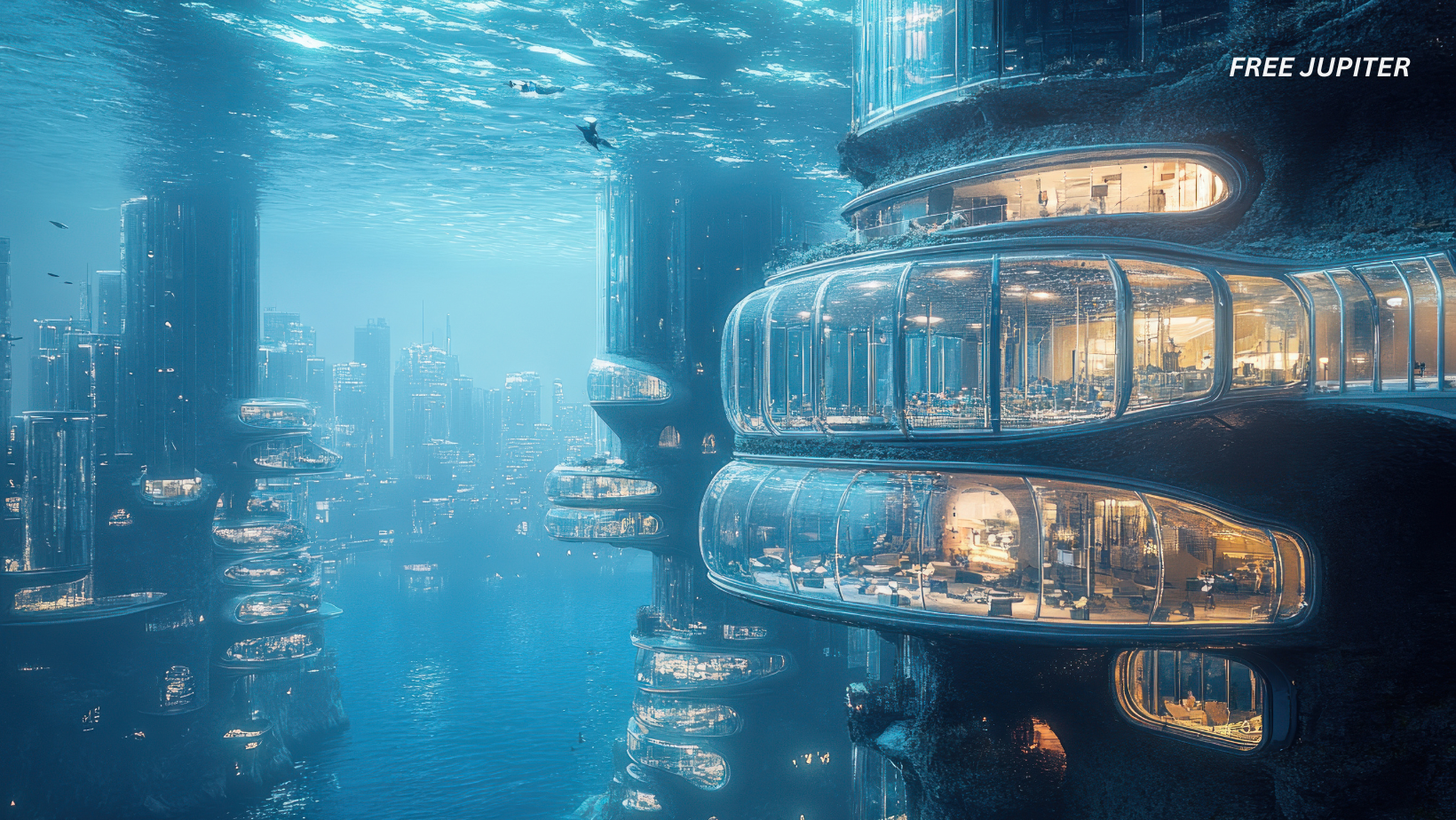Friendly Note: FreeJupiter.com shares general info for curious minds 🌟 Please fact-check all claims—and always check health matters with a professional 💙
Imagine waking up in a sleek dome under the ocean, sipping your coffee as schools of fish drift past your window like curious neighbors. No smog. No traffic. Just a quiet hum of innovation all around. As surreal as it sounds, this could become a reality thanks to a futuristic vision by Japanese construction giant Shimizu Corporation.
Their project, aptly named Ocean Spiral, isn’t just a wild architectural experiment. It’s a bold attempt to reshape how—and where—humans live in the face of climate change, overpopulation, and disappearing land. And if their plans go smoothly, this underwater city could be up and running within the next 15 years.
The Blueprint of a Submerged Civilization
Ocean Spiral is more than just a single structure—it’s a complete ecosystem engineered to survive and thrive underwater. According to Shimizu, the city would consist of three interconnected zones:
- The Floating Sphere
Sitting just beneath the sea’s surface, this colossal 500-meter-wide dome would be the main living space. Think apartment buildings, shopping centers, offices, and even hotels—imagine an underwater version of Tokyo, just more compact and a lot quieter. Transparent walls would allow residents to peer out into the deep blue, blurring the line between home and habitat. - The Spiral Pathway
Spiraling 15 kilometers downward, this helix-shaped corridor connects the floating dome to the ocean floor, descending roughly 3 to 4 kilometers below sea level. It’s not just an elevator to the deep—it’s the lifeline of the city, housing pipelines, energy infrastructure, and research stations. - The Earth Factory on the Seafloor
At the bottom of the spiral lies the heart of Ocean Spiral’s sustainability system. Here, scientists would experiment with deep-sea resources, including microorganisms capable of converting carbon dioxide into methane, a usable fuel. This oceanic lab is designed to serve as a clean, renewable source of energy and materials—transforming waste gases into something useful.
Why Build a City in the Ocean?
The question isn’t just “Why not?”—it’s “Why now?”
As sea levels rise, storms intensify, and coastlines erode, many nations—especially island countries—face a very real future of displacement. Japan itself is no stranger to the wrath of nature. Earthquakes, tsunamis, and typhoons routinely threaten its cities, making it a compelling candidate for alternative living solutions.
Ocean Spiral is more than an escape plan; it’s a proactive response to a planet in flux. Instead of abandoning the sea, the project proposes we lean into it. By living below it, we not only preserve land but also gain access to a wealth of untapped resources.
Powering a City from the Sea
One of the most revolutionary features of Ocean Spiral is its approach to energy. Rather than relying on fossil fuels or even traditional solar or wind, the city would tap directly into the ocean’s own natural processes:
- Ocean Thermal Energy Conversion (OTEC): This method harnesses the temperature difference between warm surface waters and cold deep-sea currents to generate electricity. It’s clean, constant, and especially effective in tropical waters.
- Microbial Methane Generation: Using specialized microorganisms, scientists plan to convert carbon dioxide—typically considered a waste gas—into methane, a flammable fuel. This dual-purpose process reduces greenhouse gases while creating usable energy.
- Hydraulic Desalination: The city would also produce fresh drinking water by pressurizing seawater through special membranes. Unlike traditional desalination, this process could be powered entirely by the ocean’s natural pressure systems, making it energy-efficient.
Living in an Aquarium—Or the Future?
If the idea of living under tons of water makes you uneasy, you’re not alone. Critics have pointed out the psychological and logistical challenges of long-term underwater living, from pressure regulation and emergency escape planning to sunlight deprivation.
But Ocean Spiral wouldn’t be some gloomy bunker. The sphere would be filled with natural light via fiber optics, temperature-controlled air, and lush greenery to create a balanced and calming environment. Residents would have access to entertainment, exercise, education, and healthcare—just like any modern city.
A Legacy of Outlandish Ideas—and Daring Innovations
Ocean Spiral isn’t Shimizu’s first moonshot. The company is known for dreaming big—literally. Some of their previous proposals include:
- A lunar colony with 24/7 solar power.
- A space hotel orbiting Earth.
- Floating cities built on buoyant botanical platforms.
Another Japanese firm, Obayashi Corporation, has even proposed building a space elevator—a 60,000-mile-long cable stretching from Earth into orbit. While many of these ideas remain theoretical, they signal a growing interest in solving global issues through radical design.
Not Everyone Is Sold on Utopia-in-a-Bubble
Some experts, like Professor Christian Dimmer from Tokyo University, say we need to proceed with caution. While futuristic visions like Ocean Spiral can inspire innovation, they can also distract from more grounded, community-focused solutions. He warns against leaving the future solely in the hands of corporations without public input.
“The idea of utopian living must include democratic voices,” he notes. “Cities of the future should be co-created—not just handed down from boardrooms.”
The Broader Meaning Behind the Deep Dive
What makes Ocean Spiral compelling isn’t just its architecture—it’s the shift in mindset it represents. Instead of seeing nature as something to conquer or escape, this project views the ocean as a partner. It’s about reimagining survival, not just for novelty, but for resilience.
This isn’t just a luxury playground for the rich. If done responsibly, projects like Ocean Spiral could pioneer sustainable living for climate refugees, coastal communities, and even future space colonists. The underwater city could serve as a prototype for habitats on Mars, under-ice environments in Antarctica, or other extreme locations.
What Comes Next?
Ocean Spiral is still a concept. No cement has been poured, no sphere has been floated. But the gears are turning. With backing from academics, government ministries, and private firms, the dream could soon gain traction.
If successful, it might just mark the first step toward a new way of life—one where “under the sea” is more than just a catchy song lyric. It’s home.
Read more: There’s Something in Your Poop That May Predict Imminent Death
Floating Cities in the Maldives: Rising Above a Sinking Reality
The Maldives is one of the world’s most breathtaking tropical destinations, famous for its turquoise waters, white-sand beaches, and luxury resorts. But beneath its postcard-perfect image lies a troubling truth: this island nation is on the frontlines of climate change.
With 80% of its land area sitting less than one meter above sea level, the Maldives is extremely vulnerable to rising oceans. In fact, if global temperatures continue to climb, much of the country could be underwater within decades. Instead of waiting for the sea to swallow it whole, the Maldives is choosing to adapt in the most imaginative way possible—by building floating cities.
What Is a Floating City, Exactly?
Unlike traditional land-based communities, floating cities are engineered to literally float on water. Think of them as high-tech, sustainable rafts—but big enough to house thousands of people, complete with homes, schools, shops, parks, and even canals. These buoyant urban platforms are designed to rise and fall with the tides, making them naturally resilient to sea level changes and flooding.
In 2022, the Maldives partnered with Dutch architectural firm Waterstudio and developer Dutch Docklands to launch the first-ever floating city prototype near Malé, the nation’s capital. This isn’t a sci-fi sketch—it’s being built right now, and the first units are already in the water.
A City That Moves With Nature—Not Against It
The design of the Maldives Floating City mimics the pattern of brain coral, with interlocking clusters of floating platforms linked by walkways and surrounded by protective breakwaters. Each platform is anchored to the seabed but free to move vertically with the tide—like a giant lily pad.
Key features include:
- 5,000 Housing Units: Modular, eco-friendly homes designed with natural ventilation and solar energy in mind.
- Schools, Shops & Services: Everything residents need for daily life—without having to step foot on traditional land.
- Green Corridors: Floating gardens and open spaces that promote biodiversity and provide natural cooling.
- Zero Cars: Transportation is entirely water-based or pedestrian, cutting down on emissions and noise pollution.
Read more: Google Claims That AI Will Surpass Human Intelligence By 2030, Posing Extinction Risk
Why the World Is Watching
The Maldives Floating City is the first of its kind in a tropical region, and it’s being closely monitored by urban planners, climate scientists, and policymakers around the globe. If it works here, the model could be scaled and adapted for other low-lying nations or coastal megacities, from Jakarta to Miami.
More than just a solution to sea level rise, this project represents a paradigm shift in how we think about urban design. It’s not about building higher walls to keep the ocean out—it’s about creating communities that move with nature instead of fighting it.










